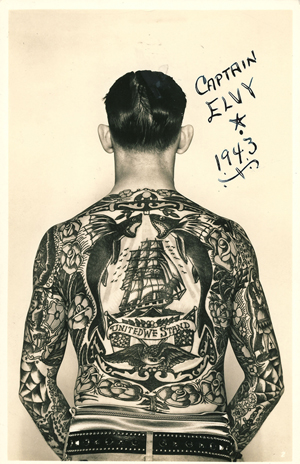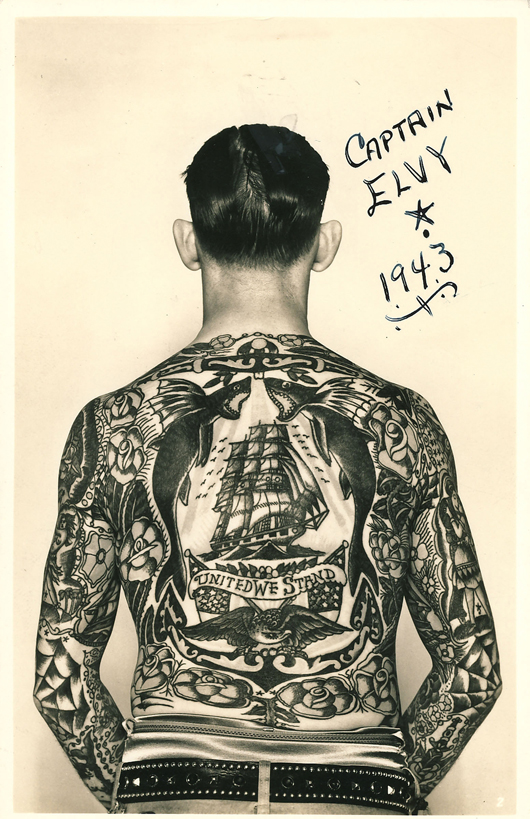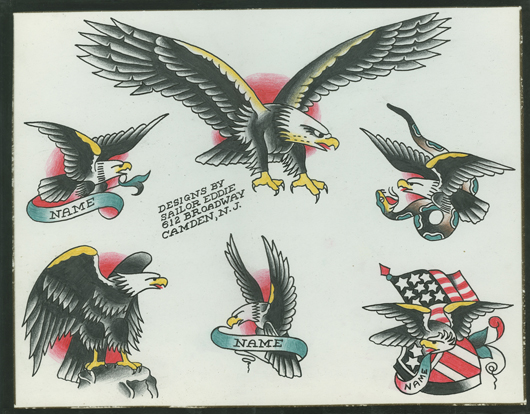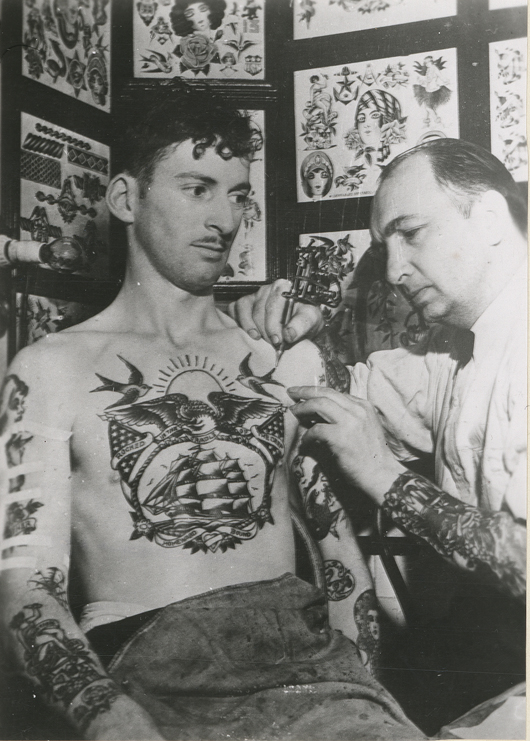
For centuries, long before their landlubber cousins sported shoulder skulls and bicep beauties, seafaring men have offered up their skin to the tattoo artist’s needle. The results are as plain as the anchor on Popeye’s forearm.
“There’s a thin wall between life and death at sea,” says Craig Bruns, curator of “Skin & Bones – Tattoos in the Life of the American Sailor,” a touring exhibition now on display at Mystic Seaport. “You’re going to want talismans for good luck, and you’re going to want them on your very body, almost like a second skin.”
Even fictitious sailors had them.
In Herman Melville’s novel Moby-Dick, for example, the imposing harpooner Queequeg was covered in tattoos. ‘This tattooing had been the work of a departed prophet and seer of his island, who, by these hieroglyphic marks, had written out on his body a complete theory of the heavens and the Earth, and a mystical treatise on the art of attaining truth,” Melville wrote. “So that Queequeg in his own proper person was a riddle to unfold; a wondrous work in one volume; but whose mysteries not even himself could read.”
“Skin & Bones” unravels some of those mysteries.
Using everything from antique needles to old postcards, it traces the connection between American sailors and tattoos from Colonial times right up to current-day U.S. Coast Guard sailors. Plus, visitors can sit at a “Tattoo-A-Tron” and get their own faux tattoo.
The exhibit debuted in 2009 at Philadelphia’s Independence Seaport Museum. Mystic is its first port of call since then, and it will remain here through Sept. 5.
“Sailors were working folks,” Bruns explains. “They were the lowest rung on the social ladder, just above slaves. They were feared. They looked weird. They had their own jargon, and they were rowdy. And they had these tattoos.”
There were practical reasons for all the body art, of course.
First, tattoos were a form of identification. Sailors had little in the way of personal possessions, and they depended on tattoos to indicate their citizenship, religious affiliation and date of birth.
Tattoos also showed where a sailor had traveled, whether he crossed the equator, how many miles he sailed, significant military battles he was in, names of ships on which he served and names of shipmates who died.
“By 1770, there was already a very complex tattoo culture,” Bruns says. “It’s a mark of masculinity. Of belonging. Of patriotism.”
“Skin & Bones” has early tattoo equipment on display, from the sail-making needles of the 1700s to the advent of Samuel O’Reilly’s electric Tattoo Machine in 1891. There also are examples of tattoo “flash” – the books of tattoo designs that served as portfolios for shipboard tattoo artists.
One of those flash books, owned by a sailor named C.H. Fellowes in about 1900, is on loan from Mystic Seaport. It’s one of the oldest flash books still in existence.
Beyond such artifacts, the exhibit is filled with the tattoos themselves.
You have dragons, American flags, hula girls, hearts, roses, ships, figureheads, coils of rope, mermaids, whales, eagles, shields, fish and stars. Some swabbies preferred the “twin screw” tattoo: a pair of propellers that sailors thought would keep them from drowning and propel them back to shore.
On one wall of the exhibit is the classic, 1944 Saturday Evening Post cover, The Tattoo Artist, painted by Norman Rockwell. It shows a brawny sailor getting the name “Betty” tattooed to his arm, underneath the crossed out names “Sadie,” “Rosietta,” “Ming Fu,” “Mimi,” “Olga” and “Sing Lee.”
There are nuggets of nautical tattoo trivia, too.
For instance, Macy’s shoppers may be interested to know that the department store’s red star logo is identical to the red star tattoo on the arm of founder Rowland Macy, who worked on a whaling ship when he was a teenager.
Here’s another tidbit. Sailors believed they could survive a shipwreck if they tattooed a pig on their left foot and a rooster on their right foot. This may be because shipboard animals traveled in crates that floated if they were tossed overboard.
“Some tattoos were very allegorical, and others were pretty direct,” Bruns says. “It was all part of being a sailor and being part of that world.”
Today’s sailors are represented in a series of video interviews with Coast Guard officers talking about their tattoos.
“There is something unique about my Neptune tattoo on my left calf,” says Emilio Mercado, a petty officer recorded at the Sector Delaware Bay Station in Philadelphia. “The tattoo doesn’t show the eyes of Neptune, since I’m acting as the eyes of Neptune right now for the United States Coast Guard and the nation. … Once I retire, the eyes will be drawn in the tattoo as a completion of my duty and to ensure safety for my own life.”
___
Online:
https://www.mysticseaport.org/
Copyright 2011 Associated Press. All rights reserved. This material may not be published, broadcast, rewritten, or redistributed.
AP-WF-04-09-11 0414GMT
ADDITIONAL IMAGES OF NOTE





